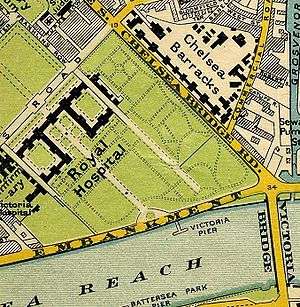Chelsea Barracks
| Chelsea Barracks | |
|---|---|
| London | |
|
Chelsea Barracks circa 1870 | |
 Chelsea Barracks Location within London | |
| Coordinates | 51°29′20″N 00°09′11″W / 51.48889°N 0.15306°WCoordinates: 51°29′20″N 00°09′11″W / 51.48889°N 0.15306°W |
| Type | Residential (Former Army Barracks) |
| Site information | |
| Owner | Qatari Diar |
| Site history | |
| Built | 1860-1862 |
| Built for | War Office |
| In use | 1862-2008 |
Chelsea Barracks was a British Army barracks located in the City of Westminster, London, adjacent to Chelsea and Belgravia, on Chelsea Bridge Road.
Today, Chelsea barracks is owned by Project Blue Ltd and is the flagship London development of Qatari Diar, a subsidiary of the Qatar Investment Authority (QIA).
History



The original barracks were designed by George Morgan to house two battalions of infantry and were completed in 1862.[1] These barracks were a long and monotonous brick structure broken by towers in the centre.[2] The original arrangement included a chapel which survives, the interior of which includes pictures of King David, the Prophet Joshua, Saint John and Saint James as well as some panels listing the names of soldiers who have been killed in action.[3] It is now a Grade II listed building.[4]
The original buildings, excluding the chapel, were demolished and, in June 1960, construction started on two 13-storey concrete tower blocks which were designed by Tripe and Wakeham and completed in 1962.[5] The tower blocks were used to accommodate four companies from the Guards Regiments.[6] A nail-bomb attack on the barracks by the Provisional Irish Republican Army in September 1981 killed two civilians.[7]
Development of the site
On 6 September 2005 Secretary of State for Defence, John Reid, announced that Chelsea Barracks would be sold. He described it as needing extensive renovations. The site was vacated in 2008 with the troops transferred to the Royal Artillery Barracks at Woolwich. The site was part of the Ministry of Defence's Project MoDEL that saw it and five other sites across London sold off, mainly for housing.[8]
Westminster City Council published its draft planning brief for the Chelsea Barracks site in September 2006. It included a commitment to develop 50% of the site with affordable housing. A Community Forum was established by local residents in April 2006 with the support of Secretary of State for Work and Pensions, John Hutton MP, to campaign for greater transparency in the sale of the barracks site and for the 50% affordable homes commitment to be realised.[9]
2007 sale
The barracks is in one of London's most expensive residential areas and was originally expected to sell for £250m.[8] In April 2007 the Ministry of Defence agreed to sell Chelsea Barracks in its 12.8 acres (5.2 ha) site for £959 million to a consortium consisting of Qatari Diar and the CPC Group. On 1 February 2008, the Joint Venture took possession of the site.[10] Subsequently CPC’s interest in the Joint Venture company, Project Blue Ltd, was acquired by Qatari Diar which now owns 100% of the site. Different design proposals for development of the site have been put forward by Richard Rogers and by Charles, Prince of Wales.[11] Squire and Partners, with Dixon Jones and landscape designer Kim Wilkie, were selected by Qatari Diar to create a master plan for Chelsea Barracks.[12]
2009 withdrawal
In early June 2009, the developers, Qatari Diar withdrew their plan to build 552 flats in 17 blocks.[13] In May 2010 some of the developers made an £81m claim at the High Court, blaming Prince Charles for the withdrawal of a planning application.The claim was later reduced to £68m and the court did not award the money.[14]
2014
Westminster Council granted detailed planning consent for the first phase of the scheme in May 2014. The phase, designed by architects Squire & Partners, consists of 68 apartments across three eight-storey blocks and includes five new garden squares.[15]
References
- ↑ "Chelsea Barracks chapel will not be listed but will survive". Evening Standard. 26 November 2009. Retrieved 11 September 2016.
- ↑ "Military Life in 1900 London: Barracks". Imperial London. Archived from the original on 20 November 2005. Retrieved 21 August 2012.
- ↑ "Listing protects Guards Chapel in £3bn Chelsea Barracks scheme". 30 March 2011. Retrieved 11 September 2016.
- ↑ "Guards' Chapel at former Chelsea Barracks". English Heritage. Retrieved 11 September 2016.
- ↑ "Chelsea Barracks, London: the officers' mess at the north-west corner of the site". RIBA. Retrieved 11 September 2016.
- ↑ "Barracks sell for record amount". BBC News. 31 January 2008. Retrieved 21 August 2012.
- ↑ "'May have hit wrong target' say Guards". 16 October 1981. Retrieved 21 August 2012.
- 1 2 "Chelsea Barracks to be sold off". BBC. 6 September 2005. Retrieved 1 April 2014.
- ↑ "Chelsea Barracks Community Forum". Retrieved 1 April 2014.
- ↑ Judith Heywood (2008-02-01). "Record £959m buys Chelsea Barracks for developers". Times Online. London. Retrieved 2009-09-02.
- ↑ Angus Laurie and Mariana Leguia (2009-08-16). "The case of Chelsea Barracks – Prince Charles and Richard Rogers". Glass Magazine. Archived from the original on 2009-08-29. Retrieved 2009-09-01.
- ↑ "Squire and Partners, Dixon Jones score Chelsea Barracks victory". Building Design. 7 December 2009. Retrieved 2010-03-08.
- ↑ Developers withdraw barracks plan, BBC News, 12 June 2009
- ↑ Prince Charles 'voiced local views' on Chelsea Barracks, BBC News, 29 June 2010
- ↑ "Chelsea Barracks Development Exhibition" (PDF). Retrieved 11 September 2016.
